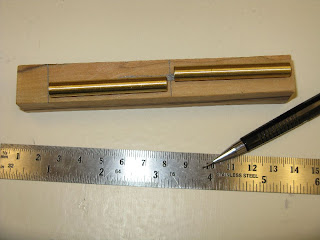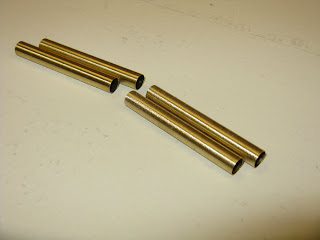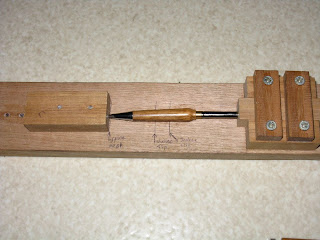Today's tutorial is pretty intense. My brother is super talented and extremely detailed in all the things he creates. His latest hobby is making pens. So if you are interested in making pens I doubt you will get a better description than the one he has put together for you. If, like for me, this seems like too much effort you can order and buy them from him. Just email me and I will get you connected. Enjoy the tutorial :)
Turning a Slimline pen on a lathe
1 x 7mm slimline pen kit (all supplies are available at Craft Supplies USA)
1 x pen blank
A pen mandrel
7mm pen bushings
A ruler
A pencil
7mm drill bit
Pen mill
5min Epoxy glue
A bamboo skewer/ thin dowel
Sandpaper (150, 220, 320, 400, 600 grits)
Friction polish
Paper towel
Drill press vise/ pen vise
Pen press / bench vise
Power tools needed:
Wood lathe
Drill press
Band saw / hand saw
Wood turning tools (I used a roughing gouge, carbide cutting tool, spindle gouge and skew, all of which can be seen in the pictures describing the turning process on the lathe below)
Place both brass tubes (from kit) on the pen blank (wooden block) and make sure that the blank is longer than the length of the two tubes combined. Mark the blank as shown in the picture leaving a little extra space to either side of each tube.
Make a mark across the center of the blank to make sure that you can keep the wood grain aligned after you have cut the blank in two.
Cut the pen blank to the marked lengths using a bandsaw .
Mark the center at the end of each of the two parts of the blank with an X using a ruler or center-finder.
Place the blank in the drill press vise and adjust it so that it is exactly parallel to the drill bit in the drill press and tighten the vise to secure the blank in place. If you have a pen vise, place the blank in the pen vise and tighten. Align the drill bit with the center of the blank that you marked with an X.
Drill a hole straight through the blank. Do it slowly, withdrawing the drill bit at intervals to remove wood chips and prevent the blank from overheating and cracking.
Do this with both blanks.
Wrap some 150 grit sandpaper around the thin dowel and use it to sand the inside of the blanks.
Using 150 grit sandpaper, sand the outside surface of the the brass tubes so that the glue has a better surface to adhere to.
Mix a small amount of Epoxy glue on a scrap piece of paper. Using the dowel, apply a thin layer of glue to the inside of each blank.
Now apply a small amount of glue to one end of the outside of the brass tubes (it will spread itself as you insert it into the blank).
Slowly insert each brass tube into a blank using a twisting motion, to spread the glue more effectively. Insert the tube all the way in so that it is not protruding from either end of the blank at all.
Set the blanks aside and allow the glue to dry completely, preferably about 24 hours.
Using the pen mill in the drill press, hold the blank with a pair of pliers or a vise and square both ends of each of the blanks (make the ends of the blank perpendicular to the brass tube). Be very careful not to cut away any of the brass tubing, check frequently and stop when you see the edge of the brass tube become shiny. Don't try to hold the blank in your hand because if it catches on the pen mill it will spin in your hand and that can be quite painful...
Place the pen mandrel in the lathe and slide at least one bushing onto the mandrel.
Slide one of the pen blank halves onto the mandrel, then one bushing and then the second blank and another bushing. Making sure that the wood grain is aligned using the marks you made before cutting the blank in half. Screw on the brass nut and tighten it against the last bushing that you placed on the mandrel.
Put a 60 degree live center in the tail stock of the lathe, slide the tail stock up against the mandrel and tighten down the tails.
Set the lathe speed to 1500-2000 rpm. Using your tool of choice (I used a roughing gouge and carbide cutting tool) See picture below.
Round the blanks starting at one end and working your way across the entire blank.
Turn down the ends of the blanks until they are only slightly bigger than the bushings (I used a spindle gouge and carbide cutting tool).
Using your tool of choice (I used a skew and carbide cutting tool) turn the blanks to the desired final shape (something that will be comfortable to hold while writing). Make sure that the ends of the blanks are the same size as the bushings or only very slightly bigger and sand them down to the same diameter as the bushings in the next step.
Turn the lathe speed down to between 500 and 800rpm. Sand the blanks starting with 150 grit sandpaper working your way through each of the grits up to 600 grit.
After each grit stop the lathe and sand along the grain (along the length of the blanks), while turning the mandrel by hand.
Wipe the sanding dust off after using each grit.
Turn the lathe speed up to about as fast as it can go (depending on the lathe you are using, anywhere between 1500-3000rpm should be fine.)
Fold a piece of paper towel as seen in the picture below, and put some friction polish on one end of the towel. Apply friction polish to each of the blanks, making sure to coat the whole blank.
Once each blank is completely covered in polish, with the lathe running, you should pinch the paper towel around the blank and move the paper towel quickly back and forth along the blanks, generating heat and activating the friction polish. You can stop when the friction polish is completely dry and the blanks are shiny.
Unscrew the brass nut and remove the bushings and blanks from the mandrel, making sure to keep the grain of the blanks aligned.
The next few steps show how to assemble the pen kit using a pen press (a bit of care keeping the parts aligned and a bench vise would also work). I used different blanks in these pictures but the process is the same.
Align the back end of the pen tip with one of the blanks and put it in the pen press, make sure to keep the tip and blank in-line while pressing them together.
Put the brass end of the twist mechanism into the other end of the blank in which you just inserted the tip. Press the mechanism into the blank up to the end of the brass piece.
Screw the pen refill into the mechanism and turn the mechanism clockwise as far as it will go.
If the tip of the refill protrudes far enough out of the tip of the pen to allow for comfortable writing and also retracts all the way in when turning the mechanism counter-clockwise, continue to the next step. If not, remove the refill from the mechanism and press the mechanism a little deeper into the pen blank. In the end you want enough of the pen tip to protrude so that writing will be comfortable and so that the tip will retract completely when not in use.
Place the end cap through the clip and align it with the back end of the remaining blank. Press them together in the pen press.
Slide the center ring (from the kit) down the twist mechanism unit. Screw the refill into the mechanism. Press the back half of the pen onto the mechanism and adjust it until the grain aligns.
And that is it.
























































1 comments:
Awesome tutorial. I have recently started turning pens and appreciate these useful tips. Most people don't realize how much work goes into just one pen. If someone gifts you one of these you should appreciate the time and craftsmanship that went into it's making.
Post a Comment